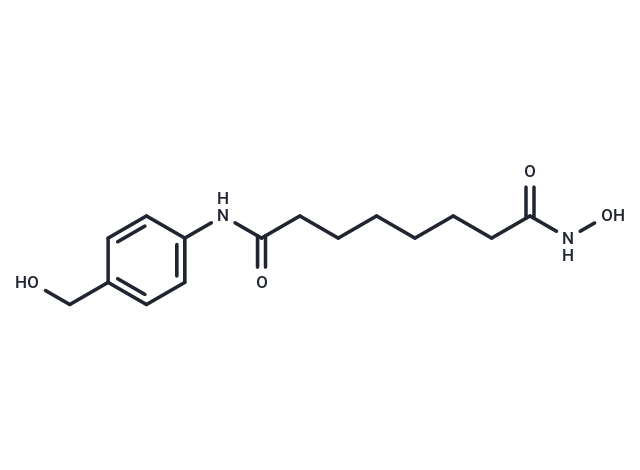Shopping Cart
Remove All Your shopping cart is currently empty
Your shopping cart is currently empty
SAHA-OH, a selective HDAC6 inhibitor with an IC50 of 23 nM, exhibits a 10- to 47-fold greater selectivity for HDAC6 over HDACs 1, 2, 3, and 8. It demonstrates anti-inflammatory effects and reduces macrophage apoptosis [1].

| Pack Size | Price | USA Warehouse | Global Warehouse | Quantity |
|---|---|---|---|---|
| 25 mg | $1,520 | 6-8 weeks | 6-8 weeks | |
| 50 mg | $1,980 | 6-8 weeks | 6-8 weeks | |
| 100 mg | $2,500 | 6-8 weeks | 6-8 weeks |
| Description | SAHA-OH, a selective HDAC6 inhibitor with an IC50 of 23 nM, exhibits a 10- to 47-fold greater selectivity for HDAC6 over HDACs 1, 2, 3, and 8. It demonstrates anti-inflammatory effects and reduces macrophage apoptosis [1]. |
| Targets&IC50 | HDAC6:23 nM, HDAC1:237 nM, HDAC3:359 nM, HDAC2:399 nM, HDAC8:1070 nM |
| In vitro | SAHA-OH, at concentrations ranging from 0.67 to 10.76 μM over a period of 51 hours, demonstrates inhibitory effects on bone marrow macrophages [1]. When applied to bone marrow-derived macrophages (BMMØs) at 0.01 μM for 3 hours, SAHA-OH significantly reduces the secretion of cytokines such as IL-6, TNFα, IFNβ, IL-1β, IL-10, MCP-1 (CCL2), and GROα (CXCL1) [1]. Additionally, a 10 μM SAHA-OH treatment for either 4 or 9 hours results in increased acetylation of cytoplasmic α-tubulin and nuclear histone H3 [1]. At dosages up to 30 μM, a 3-hour treatment with SAHA-OH effectively decreases apoptosis in macrophages and reduces death in B cells [1]. |
| In vivo | SAHA-OH, administered through intraperitoneal injection at a dose of 50 mg/kg in a single dose, mitigates splenic damage and diminishes the levels of proinflammatory cytokines in plasma in a mouse model of LPS-induced endotoxemia [1]. |
| Molecular Weight | 294.35 |
| Formula | C15H22N2O4 |
| Cas No. | 2857098-30-5 |
| Smiles | O=C(CCCCCCC(=O)NC1=CC=C(CO)C=C1)NO |
| Storage | Powder: -20°C for 3 years | In solvent: -80°C for 1 year | Shipping with blue ice/Shipping at ambient temperature. |
| Size | Quantity | Unit Price | Amount | Operation |
|---|

Copyright © 2015-2026 TargetMol Chemicals Inc. All Rights Reserved.